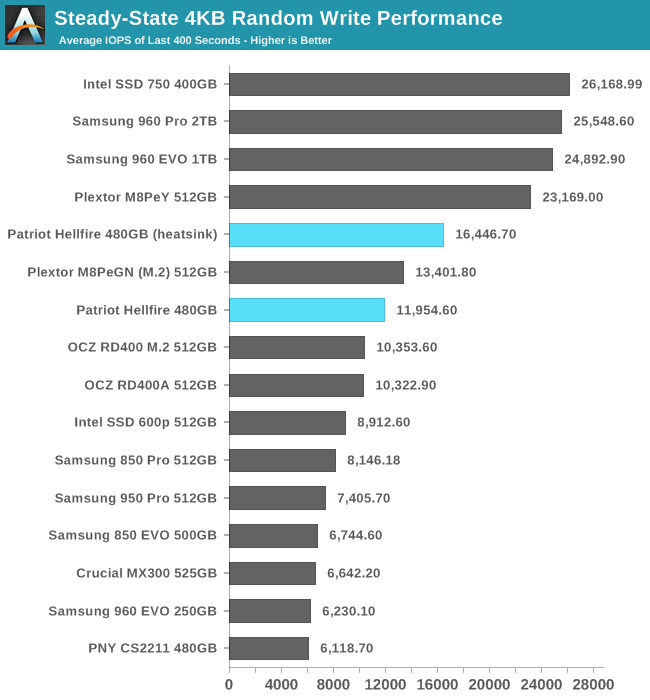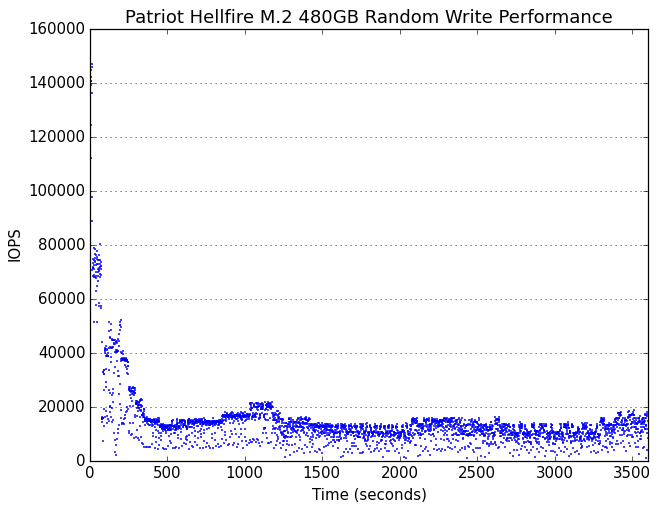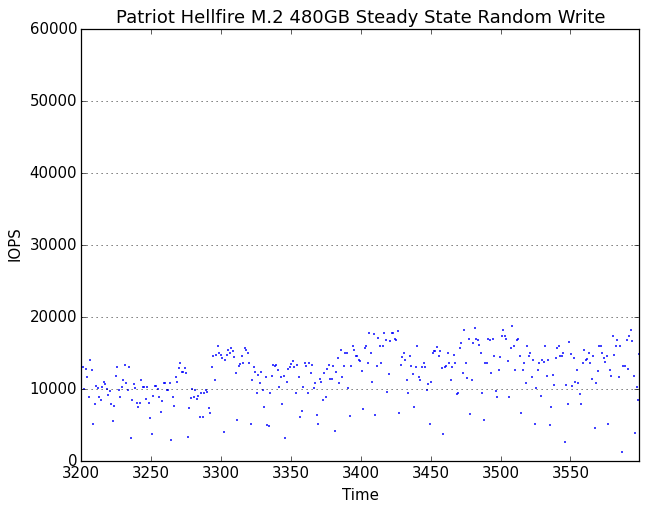The Patriot Hellfire M.2 480GB Review: Phison NVMe Tested
by Billy Tallis on February 10, 2017 8:30 AM ESTPerformance Consistency
Our performance consistency test explores the extent to which a drive can reliably sustain performance during a long-duration random write test. Specifications for consumer drives typically list peak performance numbers only attainable in ideal conditions. The performance in a worst-case scenario can be drastically different as over the course of a long test drives can run out of spare area, have to start performing garbage collection, and sometimes even reach power or thermal limits.
In addition to an overall decline in performance, a long test can show patterns in how performance varies on shorter timescales. Some drives will exhibit very little variance in performance from second to second, while others will show massive drops in performance during each garbage collection cycle but otherwise maintain good performance, and others show constantly wide variance. If a drive periodically slows to hard drive levels of performance, it may feel slow to use even if its overall average performance is very high.
To maximally stress the drive's controller and force it to perform garbage collection and wear leveling, this test conducts 4kB random writes with a queue depth of 32. The drive is filled before the start of the test, and the test duration is one hour. Any spare area will be exhausted early in the test and by the end of the hour even the largest drives with the most overprovisioning will have reached a steady state. We use the last 400 seconds of the test to score the drive both on steady-state average writes per second and on its performance divided by the standard deviation.

The Patriot Hellfire maintains a higher average random write speed than the significantly more expensive OCZ RD400 and the older Samsung 950 PRO, but the Plextor M8Pe performs even better, especially when heatsinks are used.

The Patriot Hellfire does not have the very high consistency of the Intel SSD 750 or most of Samsung's SSDs, but the score is not worryingly low. For consumer-oriented products, consistency under sustained write load is generally a lower priority than high burst performance and quick recovery during idle times.
 |
|||||||||
| Default | |||||||||
| 25% Over-Provisioning | |||||||||
The Patriot Hellfire shows some long-term fluctuations in random write performance, especially when equipped with a heatsink to allow for higher peak performance. With extra overprovisioning, the long-term trend is very stable and the effect of the heatsink is greatly reduced.
 |
|||||||||
| Default | |||||||||
| 25% Over-Provisioning | |||||||||
On shorter time scales, the Patriot Hellfire is never particularly consistent. Adding a heatsink increases the peak performance but only helps the minimums slightly. Adding extra overprovisioning greatly increases the amount of time spent operating at or near peak performance, but does not entirely eliminate the drops down below 5k IOPS.










43 Comments
View All Comments
KAlmquist - Friday, February 10, 2017 - link
"...a Phison E7 SSD might make sense at the 120 GB capacity point where Samsung has no offering..."IF the performance of the 120 GB version is close to that of the 480 GB drive. It appears that Patriot isn't sending the lower capacity drives out to reviewers. The link given below reports that the 240 GB model providing about 86% of the speed of the 480 GB model. That number may not be terribly meaningful because the reported speeds vary a lot (presumably because some drives were fuller than others when the benchmarks were run), but it seems to be the best data we have. The law of diminishing returns suggests that the performance gap between the 120 and 240 GB models will be greater than the gap between the 240 and 480 GB models. So it seems quite possible that the 120 GB model is a real dog.
http://ssd.userbenchmark.com/SpeedTest/184918/Patr...
HideOut - Friday, February 10, 2017 - link
So why is a supposedly leading tech site doing their review on Windows 8.1? There are already features and such unusable if you don't have 10Ryan Smith - Saturday, February 11, 2017 - link
We're purposely slow to switch OSes so that we can work out the kinks first. Win10 has taken a bit of time to get to place nicely with our SSD tests, though we should be ready to finally roll it out in the next couple of months.HomeworldFound - Sunday, February 12, 2017 - link
That basically means in several years when nobody is reading any more.Billy Tallis - Monday, February 13, 2017 - link
After this review, I have two engineering samples and one retail drive that I'll be reviewing with the 2015 test suite, and then I'll be switching over to the 2017 test suite using Windows 10. If all goes well and if I get enough of the back catalog of drives re-tested with the new suite in time, the WD Black may even get reviewed with the new test suite and the 2015 data will just go into the Bench archives.But you're probably overestimating how important the switch to Windows 10 is for SSD reviews. The Windows 10 NVMe driver still sucks.
leexgx - Tuesday, February 14, 2017 - link
windows 10 provides inconsistent results (unless you disable everything or use windows 10 LTSB and still disable everything) where as you can use windows 8 and have consistent resultsfanofanand - Monday, February 13, 2017 - link
Newegg has a 1 TB Mushkin Reactor for $229.99 today. Until Nvme prices come down (the increase appears to be completely artificial as they are not more expensive to make) I will be on the sidelines enjoying my "slow" Sata 3 SSD.chlamchowder - Monday, February 13, 2017 - link
Interesting how several sites tested this drive, and:-AT criticizes it for being the slowest MLC NVMe SSD and not being price compeitive with the MyDigitalSSD BPX
-Tomshardware also criticized pricing, wrt the 950 Pro (but they also had data on the BPX and showed the Hellfire slightly ahead)
-thessdreview praises it for getting close to the 960 Pro and RD400 while being less expensive
Everyone's probably right at once. From AT's price table, it looks like the Hellfire is a decent PCIe entry at 480 GB. It's cheaper than drives that outperform it while beating the cheaper BPX and 600p.
But I don't think NVMe M.2 drives are worth it right now. They're expensive, power hungry, run hot, and are harder to cool (especially next to a graphics card). I have the M8pe, and it's often hard to feel the difference compared to a good MLC SATA drive. If software changes direction to be far more IO heavy it could be worth it.
ravansranu - Tuesday, February 14, 2017 - link
Ipl T20 2017 is likely to be scheduled to start from April 3rd 2017 to May 26th, 2017. While, opening ceremony and final match of IPL 2017 is to be placed on Eden Gardens, Kolkata.https://iplilive.org
FrogSpawn - Tuesday, February 14, 2017 - link
Perhaps unrelated but what is it with these naming conventions? Hellfire, Bonecrusher, Gravedigger, MurderBox. It's not badass at all, it's ridiculous.